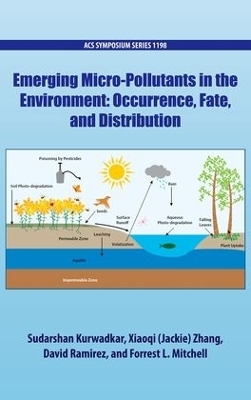
Emerging Micro-Pollutants in the Environment
Oxford University Press Inc (Verlag)
978-0-8412-3078-1 (ISBN)
Over the last decade, the major focus of pollutant research has shifted from previously established contaminants to the emerging contaminants of concern. These emerging contaminants are not of recent origin, but their analytical quantification, exposure routes and pathways and consequent human health and ecological effects are now becoming known. The Industrial Revolution introduced new materials hitherto unknown to humanity, optimized industrial processes, and
greatly improved our living standards. The net consequences of this progress is the generation and discharge of new waste streams in the environment and as such term "emerging contaminants" will remain in vogue as we continue to understand the nature, persistence, stability and related human health and
ecological risks due to these new contaminants. At this point in time, we are deliberating on emerging contaminants such as pharmaceuticals and personal care products, insecticides, poly- and perfluorinated compounds and engineered nanomaterials.
Detection of emerging contaminants in various environmental matrices including air, water, soil, and sediments has been reported in various journals and scientific reports with increasing frequency. Yet, little information exists in terms of remediation, human health and ecological risk characterization and promulgation of new regulation to deal with the problems associated with emerging contaminants. In addition to environmental impact of pharmaceuticals and insecticides, engineered
nanomaterials also emerged as emerging contaminants of concern. This book is an effort to communicate current knowledge and identify future direction so that we will be better able to manage and mitigate adverse environmental and human health consequences due to emerging contaminants. Each of the book's
chapters cover an important aspect of emerging micro-pollutants with regard to their environmental occurrence, analytical quantification, fate, transport (surface and sub-surface), persistence and removal mechanism.
Dr. Sudarshan Kurwadkar is an Assistant Professor in the Civil and Environmental Engineering Department at California State University, Fullerton. He is a Board Certified Environmental Engineer and a licensed Professional Engineer. Prior to his academic career, he worked in the Division of Environmental Quality with the Missouri Department of Natural Resources. Dr. Jackie Zhang is a Professor of Environmental Engineering in the Department of Civil & Environmental Engineering at the University of Massachusetts Lowell (Lowell, MA). Dr. David Ramirez is an Associate Professor of the Department of Environmental Engineering at Texas A&M University-Kingsville (TAMUK). He is the Director of Environmental Technology at the TAMUK's Eagle Ford Center for Research, Education and Outreach. Dr. Forrest Mitchell is a research project leader for Texas A&M AgriLife Research and professor in the Department of Entomology at Texas A&M University. He is based at the Texas A&M AgriLife Research and Extension Center in Stephenville, TX where he conducts work on insect transmitted plant diseases and diseases of insects.
1. Introduction
2. Antibiotics in the Environment: A Review
3. Emerging Micro-Pollutants Pharmaceuticals and Personal Care Products (PPCPs) Contamination Concerns in Aquatic Organisms - LC/MS and GC/MS Analysis
4. Properties of Soil Particle Size Fractions and Their Contribution on Fate and Transport of Hormones in Soil Environment
5. Modeling Fate and Transport of Emerging Micro-Pollutants in the Environment
6. A Comparative Study of the Aqueous-Phase Adsorption of Sulfamethazine onto Commercially Available and Laboratory Developed Activated Carbon
7. Identifying Knowledge Gaps in Assessing Implication of Engineered Nanomaterials on Wastewater Reuse
8. Toxicity of a Mixture of Metal Oxide Nanoparticles on Activated Sludge
9. Toxicity of Long Single-Walled Carbon Nanotubes to the Activated Sludge Process: Examination of the Effects of Extracellular Polymeric Substances
10. Assessment of Anthropogenic Contribution to Perchlorate in the Environment Using an Ice Core Record
11. Applying Advanced Mass Spectrometry Techniques to Emerging Pollutant Detection: Differential Mobility Spectrometry
| Erscheinungsdatum | 04.08.2016 |
|---|---|
| Reihe/Serie | ACS Symposium Series |
| Zusatzinfo | 47 |
| Verlagsort | New York |
| Sprache | englisch |
| Maße | 163 x 230 mm |
| Gewicht | 526 g |
| Themenwelt | Studium ► 2. Studienabschnitt (Klinik) ► Pharmakologie / Toxikologie |
| Naturwissenschaften ► Biologie ► Biochemie | |
| Naturwissenschaften ► Biologie ► Ökologie / Naturschutz | |
| Naturwissenschaften ► Chemie | |
| Technik ► Umwelttechnik / Biotechnologie | |
| ISBN-10 | 0-8412-3078-1 / 0841230781 |
| ISBN-13 | 978-0-8412-3078-1 / 9780841230781 |
| Zustand | Neuware |
| Haben Sie eine Frage zum Produkt? |
aus dem Bereich


